Case Studies
Industries
Resources
Ratings & Reviews
NEW
You know the accounts I’m talking about. Brands that gather up millions of followers, expect a high Instagram engagement rate, but keep their following count to a tight … zero.
I use Instagram mostly as a way to socialize with friends who live far away. It makes me feel a part of their lives when, living an ocean away, I’m distinctly not.
That being said, brands do make their way into my inner circle of social contacts via Instagram, as I love seeing stylish pictures of clothes I just might need to own.
But when I was doing my daily scroll of Instagram, and I noticed a brand that follows literally zero accounts, I had to take a step back.
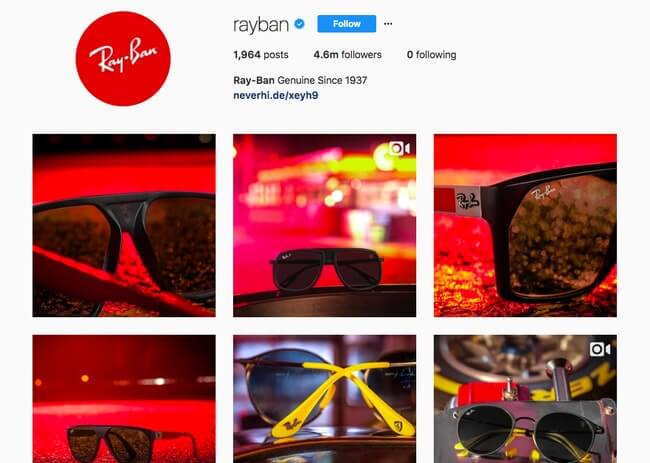
No accounts? It has millions of followers, and it follows no one?
I myself find this unattractive. Why are they joining a social network, if they’re not trying to socialize?
My first thought: this can’t be good for their Instagram engagement.
With further contemplation, I speculated that my reaction is due to my social behavior on the platform. It’s a small network for me, and I expect to see things on it that feel within reach, even when they’re not.
But maybe other users don’t feel this way. Perhaps they like to see big, chic brands retain their exclusivity by being forthright with how willing they are to socially engage with the network (zero).
Is this just a question of personal preference or are these brands taking a major engagement hit for vanity’s sake?
And is it not a risk to declare that they are choosing to disengage from the same space that they hope to attract Instagram engagement?
With Instagram marketing as a major tool, eCommerce is obsessed with engagement rate. Get more Instagram accounts to engage, make more online sales – that’s the social media marketing way. But there are a lot of big fashion brands who follow nobody. Which really makes you wonder, how much does scoring a high Instagram engagement rate require hitting the follow button?
With this in mind, our team set out to answer the question: if a brand follows no other accounts, does it affect their engagement rate?
To test this, we selected 30 luxury fashion brands at random, with between 50,000 and 8 million followers. 15 of these brands follow no other profiles on Instagram – the NO group, and 15 of them follow more than 300 (a ‘normal’ volume for a luxury brand) – the YES group. All of this data was taken before the degradation of the Instagram API in April 2018, which has since made a study of this nature impossible.
Firstly, to confirm that our data is suitable for analysis, we checked that there were no huge differences in the followerships of the NO and YES groups. In simple terms, the analysis of difference between the 2 groups should not be affected by differences of brand size on Instagram – which we know affects engagement – in order to move forward with further analysis. A simple test showed that there was no difference between our groups of data.
We’re good to go.
Originally, we hypothesized that brands who follow no other accounts appear un-engaged and, as a result, receive less engagement from their followers. To test this hypothesis, we used our internal analytics tools to create an overall measure of engagement, combining likes and comments, and then comparing the Instagram engagement levels between our YES and NO groups.
Our first result, as shown on the left of Plot 1 [below], demonstrates that when measuring engagement per post, there is no difference between the 2 groups. In fact, without further data, it suggests that brands that follow nobody (NO) actually receive more engagement per post than anticipated.
But that’s not the end of the story.
When we go on to analyze the engagement level in a different way, we find a contrasting result. Measuring engagement by the engagement per day (as shown on the right of Plot 2), we find that brands that do follow others (YES) receive considerably more engagement.
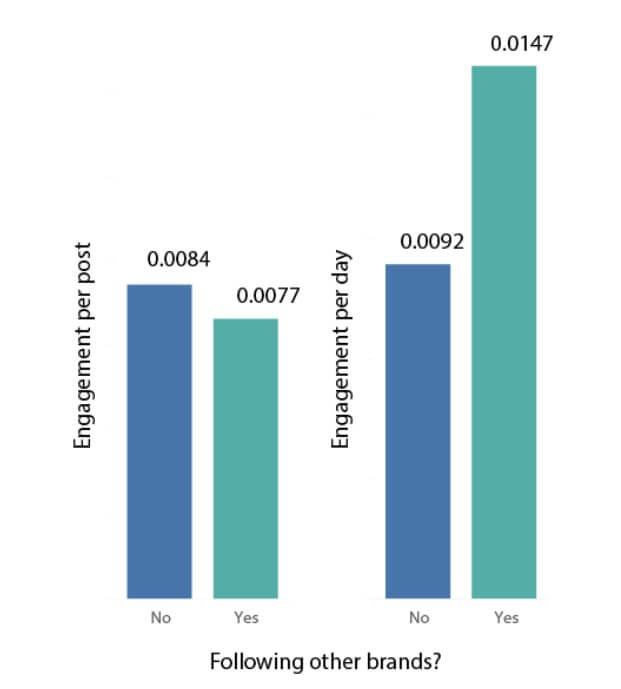
Using a t-test, we measured whether or not these differences are statistically significant, and the result was very close to proving this point. So we can’t say that it’s confirmed, but we can strongly suggest that brands who follow no one receive less Instagram engagement per day.
So what does it mean that brands that follow no one have a solid engagement rate but struggle to engage daily?
As it goes with questions of Instagram engagement, the answer is often in the marketing strategy. Every brand has their primary focuses in the grand scheme of things, and this becomes immediately clear during these tests.
This second result demonstrates that brands that do follow other users (YES) tend to be more active on Instagram – by posting more frequently. And thus they receive more engagement per day.
YES brands post an average of 2.22 times per day as compared to the NOs that clock in at 1.54 times per day.
This isn’t surprising. Brands that are more interested in spreading their follows are most likely more interested in spreading their content as well. And, conversely, if you’re not interested in following other people, you’re probably not as focused on sharing content on Instagram either.
So within this study we can see the strategic marketing differences between YES and NO brands.
But a lot of the NO brands have millions of followers. Are they not concerned about losing out on this daily marketing potential, especially with social media selling on the rise?
Luxury tailor, Brioni, doesn’t follow any accounts and has the lowest daily post count in our sample, with 0.22 posts per day.
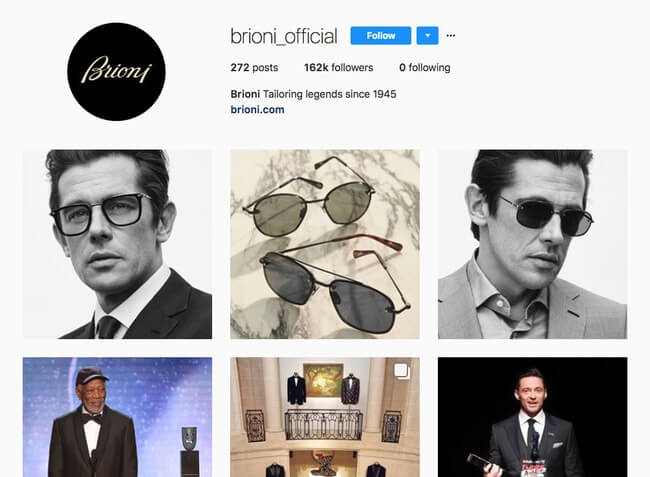
When ranked by engagement per post, they stand strong in third place.
But this brand is also posting less than 2 times per week. It’s not surprising then that their engagement per post is high, when they have so few posts with which to engage.
So then we rank our sample by daily engagement. Now Brioni is lagging at 29 – one spot away from last place in this ranking.
Our number 1 brand in this daily rank is Tommy Hilfiger. Following 652 other accounts, this highly esteemed brand posts 4.11 times per day and still maintains a moderate rank per post.
As a hugely popular fashion company, one could argue that their 6 million followers engage because of the brand’s popularity. But it’s also obvious that TH is using Instagram to their advantage. They post, engage, encourage hashtag use, and even follow other accounts. Exactly what the platform was built for.
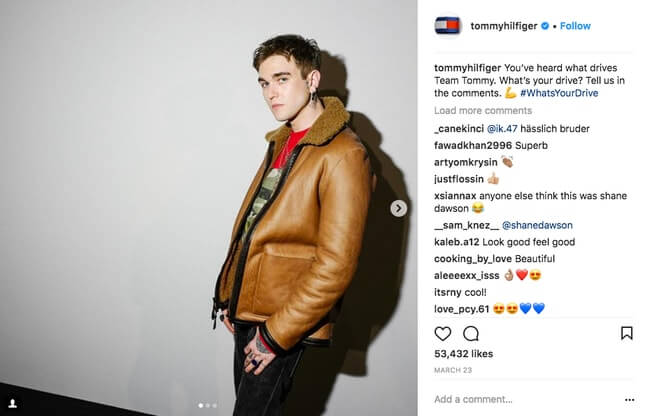
Our NO brands have to recognize that, while they appear exclusive and untouchable by following nobody, they’re essentially entering a social space and saying ‘Feel free to socialize with me, but there’s zero chance I’m socializing with you.’
Maybe vanity gives it a thumb’s up, but is basic human instinct a little less predictable?
Alongside this empirical study, we wanted to get a better idea of how people feel about brands who follow no other accounts. Do they feel an immediate distaste for brands that aren’t willing to engage with the platform – similar to my experience? Or do they look up to brands who have the power to garner millions of followers with just the influence of their brand image? Maybe they really have no preference.
In a small survey of 200 people who follow more than 5 brands on Instagram, we asked participants whether or not they are MORE or LESS likely to follow a brand that follows NO other accounts on Instagram.
What we found is really quite interesting.
Users are increasingly LESS likely to follow brands that follow nobody as the sample group gets older.
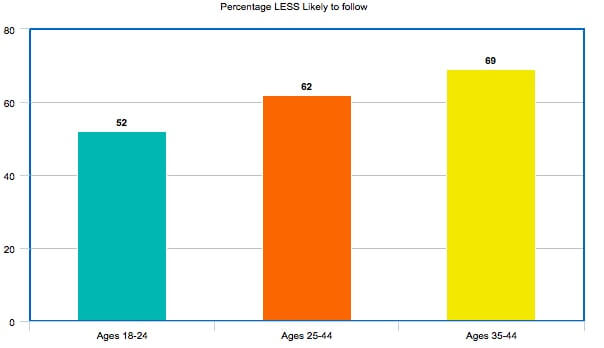
The data suggests that the older people are, the more concerned they are with social interaction by brands on Instagram. Perhaps older Instagram users are more likely to be critical of the choice to follow no one. Certainly, this result shows that for some users a brand choosing to follow nobody is a negative thing.
These people in our sample are open to following brands, and they clearly become less interested in the brands that appear distant to the platform with age. What kind of impact can this have on a brand’s product desirability, as we purchase more on social media?
And, more importantly, who is the target audience for most luxury fashion brands? (spoiler alert: you need money when purchasing high-fashion products)
Brands that choose not to follow any other accounts risk appearing apathetic towards the network and thus its potential followership, which could possibly affect the perception of that brand to a market that highly regards engagement on social media. This seems like a gamble, when the goal is to garner new followers regularly.
Although our data doesn’t prove that there’s a direct correlation between following other accounts and having a high Instagram engagement rate, it does suggest that daily engagement is affected by this choice. Which brings us to question the actions of brands on Instagram. What is their role and how will this change as Instagram continues to thrive as a key market?
If older Instagram users are less likely to follow brands that follow no other accounts, are these brands going to miss out on this selling potential as Instagram sales become more vital?
Will passive brands on social media maintain the same recognition that traditional marketing got them before? Or will one strategy come out on top?
All we can really say for sure is that these brands have lost one follower: me.
Looking for more Instagram tips? Head to our complete guide to Instagram Marketing, where you’ll find everything you need to know about promoting your products on this crucial platform.